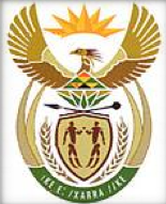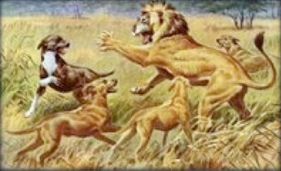RR History

The Rhodesian Ridgeback is a breed of dog from South Africa. The breed originated in Rhodesia, now Zimbabwe, where the first breed standard was written in 1922 and the Parent Club formed by Francis R. Barnes. Rhodesian Ridgebacks are sometimes called African Lion Hound or African Lion Dog (Simba Inja in Ndebele, Shumba Imbwa in Shona) because of their unique ability to harass a lion and keep it at bay, while awaiting their Master to make the kill.
from showdogs south africa:
RHODESIAN RIDGEBACK
Early Registrations of Rhodesian Ridgebacks
The renowned big-game hunter, Cornelius van Rooyen, was one of the first to deliberately breed and use ridgebacked dogs. While registration of dogs was almost unheard of in those days, it is impossible to establish how closely related or similar in type these dogs were.
The Rhodesian Ridgeback was originally known by several names, most notably, the "Lion Dog". It was under the name of Lion Dog that the first noteworthy entry was made in the records of the Kennel Union of Southern Africa on 18 September 1924, when two dogs, Grootedam Given and Grootedam Leo, were registered. A year later, Umvukwe Shumba Ridge was registered as a Rhodesian Lion Dog and dogs were registered in this way until 1926 with the registration of Eskdale Connie.
Mr Francis Barnes, founder of the Rhodesian Ridgeback Club, which was also having difficulty settling into a suitable name, suggested that because any hunting dog could justifiably be called a Lion Dog, this particular dog, with its characteristic ridge, should be called a Rhodesian Ridgeback. On 28 June 1928, a dog simply called Jumbo was the first dog to be registered as a Rhodesian Ridgeback.
from showdogs south africa:
RHODESIAN RIDGEBACK
Early Registrations of Rhodesian Ridgebacks
The renowned big-game hunter, Cornelius van Rooyen, was one of the first to deliberately breed and use ridgebacked dogs. While registration of dogs was almost unheard of in those days, it is impossible to establish how closely related or similar in type these dogs were.
The Rhodesian Ridgeback was originally known by several names, most notably, the "Lion Dog". It was under the name of Lion Dog that the first noteworthy entry was made in the records of the Kennel Union of Southern Africa on 18 September 1924, when two dogs, Grootedam Given and Grootedam Leo, were registered. A year later, Umvukwe Shumba Ridge was registered as a Rhodesian Lion Dog and dogs were registered in this way until 1926 with the registration of Eskdale Connie.
Mr Francis Barnes, founder of the Rhodesian Ridgeback Club, which was also having difficulty settling into a suitable name, suggested that because any hunting dog could justifiably be called a Lion Dog, this particular dog, with its characteristic ridge, should be called a Rhodesian Ridgeback. On 28 June 1928, a dog simply called Jumbo was the first dog to be registered as a Rhodesian Ridgeback.
Lions, Oh My!

“The Ridgeback, singly or in a pack, will silently track the lion to its lair and only on discovery of its quarry will it give tongue; tanatlising, feinting, darting in and out, just beyond the reach of those fearful slashing claws, with the nonchalance of a matador; harassing and wearing it down until that majestic creature, bewildered by such elusive impudence and weary of trying to shake off its tenacious nuisance, presents a sitting target of injured majesty.”- Capt.T.C.Hawley
From 1924 to 1974, just over ten thousand Rhodesian Ridgebacks had been registered with KUSA - not exactly an alarming number, but this was due to the fact that in the early years, a dog was often only registered a few years after birth - after it had proved itself in the show ring or at stud - and not all puppies in a litter were traditionally registered. Francis Barnes' Eskdale Dingo, for example, was registered at the grand old age of 11 years. Since June 1974, when KUSA made litter registrations compulsory within three months of birth, the picture showed a far greater number of registered dogs.
“It was July 1954, in the Tuli Block, Bechuanaland, when "Oom Kaalkop" leaned back in his special canvas chair under a shady tree, he could vividly recall every one of the nine scenes in which his old favourite "Leeuw" had bayed lions for him. As the trail became hotter, "Leeuw" would become more cautious. Silently working his way from the leeward to ascertain the rue position, he would eventually come to a dead point, with raised paw, biding his time and giving his master ample time to come up and be ready. Calculating, cool, almost mischievously he would streak into the lair, nipping the lion into action; defiantly - and successfully - challenging it into the open to a battle of wits and endurance.
Eight times he had thus succeeded in pinning down his lion and had emerged unscathed, but he was getting on in years. The old gladiator had to depend more on experience than agility when he cornered his ninth lion on the banks of the Limpopo. An overhanging "wag-'n'bietjie" branch impeded his way as the lion struck and merciless claws pierced his chest, rupturing a lung. By the following morning, "Leeuw" was dead. His remains are buried where Mopani leaves rustle; where shy, nocturnal Bushbuck browse and the dawn is still greeted by the rolling echoes of the lion's roar.
No tombstone there. I did not want to disturb the silence that followed Oom Kaalkop's story, but had there been, by silent consent I felt the epitaph would have read "One of the noblest of his kind; unflinching companion and understanding friend."
- Capt. T.C. Hawley
From 1924 to 1974, just over ten thousand Rhodesian Ridgebacks had been registered with KUSA - not exactly an alarming number, but this was due to the fact that in the early years, a dog was often only registered a few years after birth - after it had proved itself in the show ring or at stud - and not all puppies in a litter were traditionally registered. Francis Barnes' Eskdale Dingo, for example, was registered at the grand old age of 11 years. Since June 1974, when KUSA made litter registrations compulsory within three months of birth, the picture showed a far greater number of registered dogs.
“It was July 1954, in the Tuli Block, Bechuanaland, when "Oom Kaalkop" leaned back in his special canvas chair under a shady tree, he could vividly recall every one of the nine scenes in which his old favourite "Leeuw" had bayed lions for him. As the trail became hotter, "Leeuw" would become more cautious. Silently working his way from the leeward to ascertain the rue position, he would eventually come to a dead point, with raised paw, biding his time and giving his master ample time to come up and be ready. Calculating, cool, almost mischievously he would streak into the lair, nipping the lion into action; defiantly - and successfully - challenging it into the open to a battle of wits and endurance.
Eight times he had thus succeeded in pinning down his lion and had emerged unscathed, but he was getting on in years. The old gladiator had to depend more on experience than agility when he cornered his ninth lion on the banks of the Limpopo. An overhanging "wag-'n'bietjie" branch impeded his way as the lion struck and merciless claws pierced his chest, rupturing a lung. By the following morning, "Leeuw" was dead. His remains are buried where Mopani leaves rustle; where shy, nocturnal Bushbuck browse and the dawn is still greeted by the rolling echoes of the lion's roar.
No tombstone there. I did not want to disturb the silence that followed Oom Kaalkop's story, but had there been, by silent consent I felt the epitaph would have read "One of the noblest of his kind; unflinching companion and understanding friend."
- Capt. T.C. Hawley